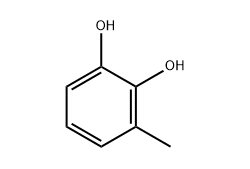3-Methylcatechol, also known as 3-methyl-1,2-benzenediol, is a derivative of catechol distinguished by a methyl group at the 3-position. It typically appears as a crystalline solid or light-colored powder, with high solubility in organic solvents such as ethanol, acetone, and ether. Buyers should note its moderate stability under controlled conditions; however, it may undergo oxidation when exposed to air or light, which can affect color and quality. Maintaining purity above 98% is important for consistent laboratory and industrial performance, making analytical verification and supplier quality critical factors when purchasing.

How 3-Methylcatechol Compares to Other Catechols
Catechols share a similar dihydroxybenzene backbone, but the position and type of substituents greatly influence their behavior. Compared with catechol itself, 3-Methylcatechol has enhanced hydrophobicity due to the methyl group, which can alter its solubility profile and reactivity in synthesis. Compared with its isomers, such as 4-Methylcatechol, it may exhibit different oxidative stability and microbial degradation pathways. For buyers, this means that selecting 3-Methylcatechol over other catechols often depends on application-specific requirements, such as compatibility with target reactions or suitability as an intermediate.
Common Applications in Research and Industry
3-Methylcatechol is widely used as a versatile chemical intermediate. In pharmaceuticals, it can serve as a building block for active pharmaceutical ingredients (APIs) and other bioactive compounds. In polymer and resin chemistry, it provides functional groups that contribute to crosslinking and performance enhancements. Environmental and microbiological research also relies on 3-Methylcatechol as a metabolic intermediate in the biodegradation of aromatic compounds, making it valuable for studying microbial pathways in bioremediation. Its broad applicability makes it attractive to both academic researchers and industrial chemists.
Handling and Safety Considerations
Safe handling of 3-Methylcatechol is essential for maintaining both product integrity and workplace safety. The compound should be handled in well-ventilated areas, with protective gloves, goggles, and laboratory coats to avoid direct contact. It can be irritating to skin, eyes, and respiratory tracts, so proper personal protective equipment (PPE) is non-negotiable. Storage in sealed containers, away from heat, air, and strong oxidizing agents, helps preserve stability. Laboratories and industries should also follow local regulations for waste disposal, as catechol derivatives may pose environmental risks if not managed properly.
Choosing the Right Catechol Derivative for Your Needs
Deciding between catechol derivatives depends on end-use requirements. For researchers focusing on microbial degradation pathways or specialized synthesis, 3-Methylcatechol offers a unique balance of reactivity and stability. If a higher degree of hydrophilicity or different substitution reactivity is required, other catechols such as unsubstituted catechol or 4-Methylcatechol may be better suited. Evaluating factors such as solubility, oxidative behavior, and compatibility with reaction conditions ensures that buyers make the right choice for their specific applications.
Where to Source High-Quality 3-Methylcatechol
Reliable sourcing is critical to ensure reproducibility and product consistency. Buyers should seek suppliers that provide detailed Certificates of Analysis (CoA), batch traceability, and assurances of high purity. Consistency in product quality reduces the risks of failed experiments or production inefficiencies. For those looking for a trusted partner, we ChemPacific stands out as a dependable supplier of 3-Methylcatechol and related specialty chemicals. With a commitment to quality, technical support, and customer-focused service, we ChemPacific provides researchers and industries with the confidence needed to integrate 3-Methylcatechol effectively into their work.
3-Methylcatechol’s unique chemical structure gives it properties and applications that set it apart from other catechol derivatives. From pharmaceutical intermediates to bioremediation research, it continues to serve as a valuable compound across diverse fields. Ensuring safe handling, correct selection, and sourcing from reliable suppliers allows buyers to fully harness the benefits of 3-Methylcatechol in both laboratory and industrial settings.



